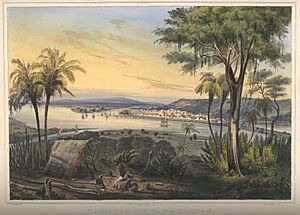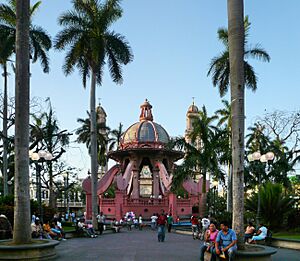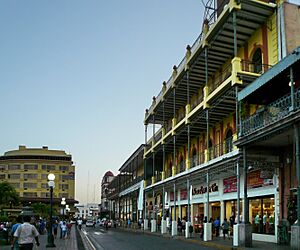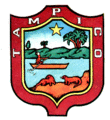Tampico facts for kids
Quick facts for kids
Tampico
|
||
|---|---|---|
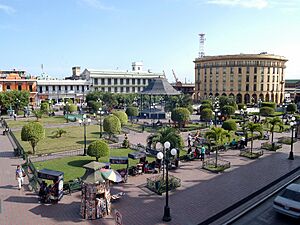
Plaza de la Libertad in Tampico
|
||
|
||
| Country | ||
| State | Tamaulipas | |
| Founded | April 13, 1823 | |
| Area | ||
| • City | 92.73 km2 (35.80 sq mi) | |
| Elevation | 10 m (30 ft) | |
| Population
(2015)
|
||
| • City | 314,418 | |
| • Density | 4,338/km2 (11,240/sq mi) | |
| • Metro | 929,174 | |
| • Demonym | Tampican (Spanish: Tampiqueño) | |
| GDP (PPP, constant 2015 values) | ||
| • Year | 2023 | |
| • Total | $23.4 billion | |
| Time zone | UTC-6 (Central Standard Time) | |
Tampico is a vibrant city and important port located in the southeastern part of the Mexican state of Tamaulipas. It sits on the north bank of the Pánuco River, about 10 kilometers (6 miles) inland from the Gulf of Mexico. The city is just north of the state of Veracruz.
Tampico is the fifth-largest city in Tamaulipas. In 2015, it had a population of 314,418 people in the city itself. If you include the surrounding areas, the metropolitan area had about 929,174 residents.
In the early 1900s, during Mexico's first oil boom, Tampico became a huge oil-exporting port. It was the main one in the Americas and the second busiest in the world! The money earned from oil helped build the city's beautiful architecture. Many people compared its buildings to those in Venice, Italy, and New Orleans in the United States. The very first oil well in Mexico was drilled near Tampico in 1901.
Today, Tampico also exports silver, copper, and lumber. It also ships out farm products like wool and hemp. Large shipping containers are mostly handled by the nearby port of Altamira.
Contents
A Look Back: Tampico's History
The name "Tampico" comes from the Huastec people. Tam-piko means "place of otters" or "water dogs." The city is surrounded by rivers and lagoons where many otters used to live. People have lived in this area for hundreds of years. The Huastec people had several early settlements here. One important site was Las Flores, which was a thriving community between AD 1000 and 1250.
Early Settlements and Spanish Influence
In 1532, during the Spanish colonial period, a Franciscan priest named Andrés de Olmos started a mission and monastery. He built it on top of an old Huastec village. Later, in 1554, Spanish officials founded a settlement called San Luis de Tampico. However, this site was left empty in 1684. The people moved south of the Pánuco River because pirates often attacked the area. The region remained empty for almost 150 years.
The current city of Tampico was founded on April 13, 1823. This was after Mexico became independent from Spain. The city was built on the north bank of the Pánuco River, about 10 kilometers (6 miles) from the Gulf of Mexico. Tampico's economy grew by exporting silver. It also became a key trading center for the surrounding farming region.
In August 1829, Spain tried to take back control of Mexico. They sent troops from Cuba to invade Tampico. But in September, General Antonio López de Santa Anna made the Spanish troops surrender. This reestablished Mexican control over Tampico.
The Oil Boom and Modern Times
The first oil well in Mexico was drilled near Tampico in 1901. It was in a place called Ébano. An American named Edward Doheny drilled it. He started the Mexican Petroleum Corporation. In the early 1900s, many American companies invested in oil in Tampico. A large community of Americans lived there because of the oil industry.
The oil fields around Tampico were so rich that they were called the "Golden Belt." Oil was often moved on barges along the rivers. To make it easier to transport oil to the port, the government built the Chijol Canal. This canal is 1.8 meters (6 feet) deep and 7.6 meters (25 feet) wide. It runs 120 kilometers (75 miles) south through the oil fields to Tuxpan.
During the Mexican Revolution (around 1910-1920), there was an incident in Tampico. On April 9, 1914, 10 Mexican soldiers and nine U.S. Navy sailors had a misunderstanding. The U.S. forces were trying to get fuel supplies. The American sailors were arrested but later freed. This event, known as the Tampico Affair, led to the U.S. sending naval forces to occupy the port of Veracruz for seven months. This action contributed to the downfall of Mexican President Victoriano Huerta.
In the 1970s, Tampico grew and included the nearby port city of Ciudad Madero. This city is now part of the Tampico metropolitan area. Today, Tampico has a modern port with excellent facilities. It also has train and air connections to Mexico City and the United States.
In 1938, the Mexican government took control of the oil industry. This has been the case for many years. However, in 2014, President Enrique Peña Nieto announced a change. He invited private companies to return to the oil and gas industry. This means new opportunities for oil exploration, even in older fields near Tampico.
Amazing Architecture
Tampico's downtown area has a mix of different building styles. This shows how the city grew during the time of President Porfirio Díaz. During the oil boom in the early 1900s, many grand buildings were constructed. People often compared the architecture to Venice, Italy, and New Orleans in the United States.
Many buildings have beautiful wrought-iron balconies. In the 20th century, these were often made from English cast iron. Similar balconies are common in New Orleans, which has French and Spanish-influenced architecture. Some balconies in Plaza de la Libertad even have original plaques. These show they were made in England by Andrew Handyside and Company.
Important buildings include the neoclassical Town Hall, also called Palacio Municipal, in Plaza de Armas. Another is the English redbrick Customs House by the docks. The New Orleans-style architecture is common because of the oil boom. There was a lot of money to spend, and many building materials, including parts for houses, were shipped from New Orleans to Tampico during this fast growth period. The historic downtown areas around Plaza de Armas and Plaza de Libertad have been restored. This helps highlight their historical beauty and attract more visitors.
Tampico Cathedral
The Cathedral of Tampico, also known as the Temple of the Immaculate Conception, is in Plaza de Armas. It was built in the late 1800s and has been restored several times. It has a neoclassical style with light brown stone and Corinthian-style columns. Three large doors form the entrance. Its two towers have three sections. The eastern tower has a big public clock made in London. This clock was a gift from Don Angel Sainz Trapaga.
Inside, the cathedral has recently been updated. It features several wall paintings and other artworks. The altar is made of white Carrara marble. An American oil tycoon named Edward Doheny helped fund the cathedral's construction and upkeep. He drilled the first oil well in Mexico near Tampico and based his oil operations there after 1902.
People of Tampico
According to the INEGI 2010 census, the city of Tampico had 297,284 people. The entire municipality of Tampico had 297,554 residents. Both ranked fifth in the state of Tamaulipas. The larger Tampico metropolitan area, which includes Ciudad Madero and Altamira, had about 859,419 people in 2010. The municipality covers an area of 92.73 square kilometers (35.80 square miles).
Geography and Climate
The city is located on the north bank of the Pánuco River. It is about 10 kilometers (6 miles) inland from the Gulf of Mexico. Tampico is directly north of the state of Veracruz.
Tampico's Weather
Tampico has a tropical savanna climate. This means it has warm temperatures all year. While spring and autumn are mild, summers are hot. The average high temperature in August reaches 32 °C (90 °F). The average low in August is 23 °C (74 °F). Winters are warm, with an average high of 23 °C (73 °F) in January and an average low of 13 °C (58 °F). Rain is common from June through October.
Tampico is a very humid city. In summer, the heat index can feel like 40 °C (104 °F). It is located by the Pánuco River and surrounded by wetlands near the Gulf of Mexico. In autumn and winter, cold fronts from the gulf bring strong winds. These winds can reach 50 km/h (37 mph), with gusts up to 80 km/h (50 mph). Tampico is also in a hurricane area. However, it has not been directly hit by a hurricane since October 1966.
Sometimes, the city experiences surprisingly low temperatures. In early February 2011, a cold wave caused temperatures to drop to 0 °C (32 °F). In February 1895, snow was even reported in Tampico! This is the farthest south snow has been reported at a coastal location in North America. It makes Tampico one of the few places where snow has fallen in the tropics at sea level.
| Climate data for Tampico (1981–2010) | |||||||||||||
|---|---|---|---|---|---|---|---|---|---|---|---|---|---|
| Month | Jan | Feb | Mar | Apr | May | Jun | Jul | Aug | Sep | Oct | Nov | Dec | Year |
| Record high °C (°F) | 37.0 (98.6) |
36.5 (97.7) |
43.0 (109.4) |
43.4 (110.1) |
43.5 (110.3) |
40.4 (104.7) |
38.0 (100.4) |
40.2 (104.4) |
39.0 (102.2) |
38.8 (101.8) |
37.5 (99.5) |
36.2 (97.2) |
43.5 (110.3) |
| Mean daily maximum °C (°F) | 22.9 (73.2) |
24.3 (75.7) |
26.8 (80.2) |
29.3 (84.7) |
31.2 (88.2) |
32.0 (89.6) |
32.0 (89.6) |
32.4 (90.3) |
31.6 (88.9) |
29.9 (85.8) |
27.0 (80.6) |
24.1 (75.4) |
28.6 (83.5) |
| Daily mean °C (°F) | 18.8 (65.8) |
20.1 (68.2) |
22.8 (73.0) |
25.5 (77.9) |
27.7 (81.9) |
28.6 (83.5) |
28.5 (83.3) |
28.7 (83.7) |
27.9 (82.2) |
26.0 (78.8) |
22.9 (73.2) |
19.9 (67.8) |
24.8 (76.6) |
| Mean daily minimum °C (°F) | 14.7 (58.5) |
15.9 (60.6) |
18.8 (65.8) |
21.7 (71.1) |
24.2 (75.6) |
25.1 (77.2) |
24.9 (76.8) |
25.0 (77.0) |
24.2 (75.6) |
22.0 (71.6) |
18.8 (65.8) |
15.8 (60.4) |
20.9 (69.6) |
| Record low °C (°F) | 1.0 (33.8) |
1.4 (34.5) |
8.0 (46.4) |
12.0 (53.6) |
15.2 (59.4) |
19.5 (67.1) |
20.0 (68.0) |
19.5 (67.1) |
16.5 (61.7) |
9.0 (48.2) |
5.4 (41.7) |
−1.5 (29.3) |
−1.5 (29.3) |
| Average rainfall mm (inches) | 26.3 (1.04) |
21.4 (0.84) |
17.2 (0.68) |
22.5 (0.89) |
53.5 (2.11) |
177.6 (6.99) |
146.8 (5.78) |
157.9 (6.22) |
280.4 (11.04) |
144.7 (5.70) |
44.5 (1.75) |
44.3 (1.74) |
1,137.1 (44.77) |
| Average rainy days (≥ 0.1 mm) | 5.8 | 5.0 | 3.6 | 3.9 | 4.5 | 9.7 | 11.6 | 12.0 | 14.6 | 9.6 | 6.8 | 6.5 | 93.6 |
| Average relative humidity (%) | 78 | 78 | 77 | 77 | 78 | 78 | 78 | 77 | 78 | 77 | 78 | 77 | 78 |
| Mean monthly sunshine hours | 127 | 142 | 181 | 194 | 227 | 236 | 224 | 236 | 190 | 200 | 163 | 121 | 2,241 |
| Source 1: SMN (humidity 1981–2000) | |||||||||||||
| Source 2: Ogimet (sun 1981–2010) | |||||||||||||
Getting Around: Transportation
The Tampico metropolitan area, which includes Ciudad Madero and Altamira, is served by the General Francisco Javier Mina International Airport. This airport is located in the northern part of Tampico. It has flights to Mexican cities like Mexico City and Monterrey. It also offers international flights, with daily service to Houston, Texas.
The city also has excellent railway connections that serve the port. The port is well-developed with warehouses and equipment for loading oil tankers. Major roads connect Tampico to the Pan-American Highway.
Delicious Food
Tampico is famous for its amazing food! Seafood is a very important part of the local cuisine. The people from Tampico are even informally known as Jaibas, which means crabs. You can see the crab symbol in many places, from sports logos to bus sides and park benches.
There are also special local dishes. One popular item is the "torta de la barda," which is a sandwich with more than 12 different toppings! Another famous dish is the "tampiqueña." This is a steak served with refried beans and "entomatadas" (tortillas covered in tomato sauce and cheese).
Learning and Education
The Autonomous University of Tamaulipas has one of its two largest campuses in Tampico. The other is in Ciudad Victoria. Many important schools are based here, including those for medicine, engineering, nursing, dentistry, architecture, and business.
Tampico also has many high schools, both private and public.
Sports Fun
Tampico has a professional soccer team called Tampico Madero F.C.. It was founded in 1945 and is also known as La Jaiba Brava (The Brave Crab). They currently play in the Ascenso MX, which is the second level of the Mexican football league system. Their home stadium is the 19,415-seat Estadio Tamaulipas, which they have used since 1966.
In 1953, Tampico Madero won the championship of the México Primera División. They also won the Campeón de Campeones title that year. La Jaiba Brava won the Copa México two years in a row, in 1960 and 1961. The club spent most of the 1960s and 1970s in lower leagues but returned to the Primera División for the 1977–78 season. They finished second twice in the 1985 and 1986 tournaments before being relegated again in the early 1990s.
Famous People from Tampico
- Juan García Esquivel (1918–2002), a pianist and composer known as "The King of Space Age Pop"
- Eugenio Siller (born 1981), an actor
- Ernesto Corripio Ahumada (1919–2008), a former Archbishop of Mexico
- Linda Christian (1923–2011), an actress
- Mauricio Garcés (1926–1989), an actor
- Roberto Cantoral (1935–2010), a composer and songwriter
- Ana María Rabatté y Cervi (1933–2010), a writer and poet, famous for "En Vida, Hermano... en vida"
- Carlos Sens Rendon (born 1941), an artist and muralist known for his large mural in the Palacio Municipal
- James Carlos Blake (born 1947), an American novelist
- Everette Lee DeGolyer (1886–1956), a famous oilman and philanthropist
- Rodrigo González (1950–1985), a rock musician
- José Ángel Gurría Treviño (born 1950), former Mexican Treasury Secretary
- Víctor Manuel Vucetich (born 1955), a retired soccer player and current manager
- Rafael Sebastián Guillén Vicente (born 1957), believed by the Mexican government to be Subcomandante Marcos
- Joaquín del Olmo (born 1969), a retired international soccer player
- Cecilia Suárez (born 1971), a film and television actress
- Erika Alcocer Luna (born 1974), a singer who won the reality show La Academia
- Eugenio Siller (born 1977), an actor and singer
- Kika Edgar (born 1977), an actress and singer
- Alejandro Gomez Monteverde (born 1977), a film director
- Alicja Bachleda-Curuś (born 1983), a Polish actress and singer
- Jesús Santa Cruz (born 1986), a Mexican soccer player
- Rodolfo Cazaubón (born 1989), a professional golfer
- Paulina Goto (born 1991), an actress and singer
- Rodolfo Pizarro (born 1994), an association football midfielder
Images for kids
See also
 In Spanish: Tampico para niños
In Spanish: Tampico para niños





